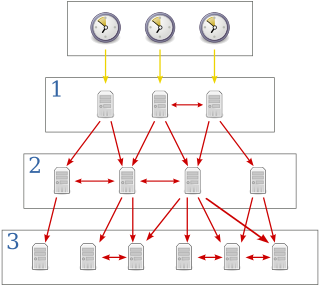Related Research Articles
The Dynamic Host Configuration Protocol (DHCP) is a network management protocol used on Internet Protocol (IP) networks for automatically assigning IP addresses and other communication parameters to devices connected to the network using a client–server architecture.
In computer network engineering, an Internet Standard is a normative specification of a technology or methodology applicable to the Internet. Internet Standards are created and published by the Internet Engineering Task Force (IETF). They allow interoperation of hardware and software from different sources which allows internets to function. As the Internet became global, Internet Standards became the lingua franca of worldwide communications.

Internet Protocol version 6 (IPv6) is the most recent version of the Internet Protocol (IP), the communications protocol that provides an identification and location system for computers on networks and routes traffic across the Internet. IPv6 was developed by the Internet Engineering Task Force (IETF) to deal with the long-anticipated problem of IPv4 address exhaustion, and was intended to replace IPv4. In December 1998, IPv6 became a Draft Standard for the IETF, which subsequently ratified it as an Internet Standard on 14 July 2017.
The Internet protocol suite, commonly known as TCP/IP, is a framework for organizing the set of communication protocols used in the Internet and similar computer networks according to functional criteria. The foundational protocols in the suite are the Transmission Control Protocol (TCP), the User Datagram Protocol (UDP), and the Internet Protocol (IP). Early versions of this networking model were known as the Department of Defense (DoD) model because the research and development were funded by the United States Department of Defense through DARPA.
A datagram is a basic transfer unit associated with a packet-switched network. Datagrams are typically structured in header and payload sections. Datagrams provide a connectionless communication service across a packet-switched network. The delivery, arrival time, and order of arrival of datagrams need not be guaranteed by the network.
Simple Network Management Protocol (SNMP) is an Internet Standard protocol for collecting and organizing information about managed devices on IP networks and for modifying that information to change device behavior. Devices that typically support SNMP include cable modems, routers, switches, servers, workstations, printers, and more.
In computing, Internet Protocol Security (IPsec) is a secure network protocol suite that authenticates and encrypts packets of data to provide secure encrypted communication between two computers over an Internet Protocol network. It is used in virtual private networks (VPNs).

Network address translation (NAT) is a method of mapping an IP address space into another by modifying network address information in the IP header of packets while they are in transit across a traffic routing device. The technique was originally used to bypass the need to assign a new address to every host when a network was moved, or when the upstream Internet service provider was replaced, but could not route the network's address space. It has become a popular and essential tool in conserving global address space in the face of IPv4 address exhaustion. One Internet-routable IP address of a NAT gateway can be used for an entire private network.
Dynamic DNS (DDNS) is a method of automatically updating a name server in the Domain Name System (DNS), often in real time, with the active DDNS configuration of its configured hostnames, addresses or other information.
Internet Small Computer Systems Interface or iSCSI is an Internet Protocol-based storage networking standard for linking data storage facilities. iSCSI provides block-level access to storage devices by carrying SCSI commands over a TCP/IP network. iSCSI facilitates data transfers over intranets and to manage storage over long distances. It can be used to transmit data over local area networks (LANs), wide area networks (WANs), or the Internet and can enable location-independent data storage and retrieval.
A virtual private network (VPN) is a mechanism for creating a secure connection between a computing device and a computer network, or between two networks, using an insecure communication medium such as the public Internet.

The Network Time Protocol (NTP) is a networking protocol for clock synchronization between computer systems over packet-switched, variable-latency data networks. In operation since before 1985, NTP is one of the oldest Internet protocols in current use. NTP was designed by David L. Mills of the University of Delaware.
In computing, Internet Key Exchange is the protocol used to set up a security association (SA) in the IPsec protocol suite. IKE builds upon the Oakley protocol and ISAKMP. IKE uses X.509 certificates for authentication ‒ either pre-shared or distributed using DNS ‒ and a Diffie–Hellman key exchange to set up a shared session secret from which cryptographic keys are derived. In addition, a security policy for every peer which will connect must be manually maintained.
Internet Security Association and Key Management Protocol (ISAKMP) is a protocol defined by RFC 2408 for establishing security association (SA) and cryptographic keys in an Internet environment. ISAKMP only provides a framework for authentication and key exchange and is designed to be key exchange independent; protocols such as Internet Key Exchange (IKE) and Kerberized Internet Negotiation of Keys (KINK) provide authenticated keying material for use with ISAKMP. For example: IKE describes a protocol using part of Oakley and part of SKEME in conjunction with ISAKMP to obtain authenticated keying material for use with ISAKMP, and for other security associations such as AH and ESP for the IETF IPsec DOI.
Internet security is a branch of computer security. It encompasses the Internet, browser security, web site security, and network security as it applies to other applications or operating systems as a whole. Its objective is to establish rules and measures to use against attacks over the Internet. The Internet is an inherently insecure channel for information exchange, with high risk of intrusion or fraud, such as phishing, online viruses, trojans, ransomware and worms.
In computing, the robustness principle is a design guideline for software that states: "be conservative in what you do, be liberal in what you accept from others". It is often reworded as: "be conservative in what you send, be liberal in what you accept". The principle is also known as Postel's law, after Jon Postel, who used the wording in an early specification of TCP.
The internet layer is a group of internetworking methods, protocols, and specifications in the Internet protocol suite that are used to transport network packets from the originating host across network boundaries; if necessary, to the destination host specified by an IP address. The internet layer derives its name from its function facilitating internetworking, which is the concept of connecting multiple networks with each other through gateways.
A Request for Comments (RFC), in the context of Internet governance, is a type of publication from the Internet Engineering Task Force (IETF) and the Internet Society (ISOC), usually describing methods, behaviors, research, or innovations applicable to the working of the Internet and Internet-connected systems.

Stephen Thomas Kent is an American computer scientist, noted for his contributions to network security.
ChaCha20-Poly1305 is an authenticated encryption with additional data (AEAD) algorithm, that combines the ChaCha20 stream cipher with the Poly1305 message authentication code. Its usage in IETF protocols is standardized in RFC 8439. It has fast software performance, and without hardware acceleration, is usually faster than AES-GCM.
References
- ↑ Kent, S. (2005). "RFC 4301 - Security Architecture for the Internet Protocol". IETF.org. Internet Engineering Task Force. doi:10.17487/RFC4301 . Retrieved 20 July 2016.
- ↑ Jose Rolim (30 March 1999). Parallel and Distributed Processing: 11th [i.e. 11] IPPS/SPDP'99 Workshops Held in Conjunction with the 13th International Parallel Processing Symposium and 10th Symposium on Parallel and Distributed Processing, San Juan, Puerto Rico, USA, April 12-16, 1999 : Proceedings. Springer Science & Business Media. p. 391. ISBN 978-3-540-65831-3.
- ↑ R. Shirey (August 2007). Internet Security Glossary, Version 2. Network Working Group. doi: 10.17487/RFC4949 . RFC 4949.Informational.